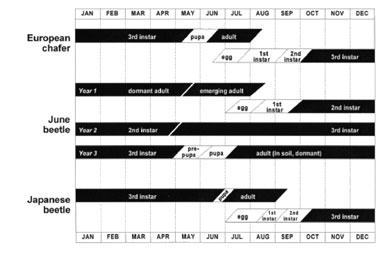grubs
Beginner
Scientific Name
European Chafer, Rhizotrogus majalis. June Beetle, Phyllophaga anxia.
Identification
- European chafer larvae:
- White and C-shaped with an orange-brown head and dark posterior
- Can be distinguished from other white grubs by its Y-shaped pattern of anal bristles known as rasters located on the underside of the last abdominal segment of the larva
- The adult is a medium-sized, light-brown, fawn-coloured, oval scarab beetle, closely resembling the native June beetle
- June beetle larvae:
- Similar in shape and size to chafers
- They can be distinguished by the oval-shaped pattern of the rasters on the posterior end of the larvae
- June beetles are most commonly associated in fields following turf, pasture or berry crops
- Both types of grubs feed on the roots of emerging seedlings, causing them to wilt and die. When pulled, affected plants will be root-less
Often Confused With
3-5 leaf die-back
Period of Activity
Sweet corn is most susceptible to grub damage during the seedling stages. Once it reaches the 6- 10 leaf-stage, economic damage is unlikely. Chafer grubs may be found in corn fields from mid-May to mid-June. June beetle grubs may be present in the field at anytime, although they are most common after a perennial crop such as pasture, turf or berries.
Scouting Notes
Scout for white grubs in the fall or early spring, prior to planting. June beetle grubs may be present where sweet corn follows a perennial crop. Chafers are often present on sandy knolls in fields with a history of chafer damage. Both types of grubs can be found in the top 10 cm (4 in.) of soil.
Using a shovel, dig up approximately 25cm x 25cm (1 sq. ft) of soil, about 7.5- 10 cm (3-4 in.) deep at a minimum of five at different locations in the field. Record the number and size of any grubs found. Use the raster pattern to distinguish between chafers and June beetle grubs.
Thresholds
None established. Avoid planting early sweet corn if the grub populations are high.
Advanced
Scientific Name
European Chafer, Rhizotrogus majalis. June Beetle, Phyllophaga anxia.
White grubs and European chafers are occasional pests of sweet corn, especially on coarse, sandy-loam soils.
Identification
European chafer larvae are white and C-shaped with an orange-brown head and dark posterior. This pest can be distinguished from other white grubs by its Y-shaped pattern of anal bristles known as rasters, located on the underside of the last abdominal segment of the larva. The adult is a medium-sized, light-brown, fawn-coloured, oval scarab beetle, closely resembling the native June beetle.
June beetle larvae are similar in shape and size to chafers. They can be distinguished by the oval-shaped pattern of the rasters on the posterior end of the larvae. June beetles are most commonly associated in fields following turf, pasture or berry crops.
Both types of grubs feed on the roots of emerging seedlings, causing them to wilt and die. When pulled, affected plants will be root-less.
Often Confused With
3-5 leaf die-back
Biology
European chafer have a one-year life cycle. Adults lay their eggs in moist soil during June and July. The larvae hatch from these eggs and begin feeding late-July or early-August until the ground freezes. The larvae then move deeper into the ground, coming back up in the spring to feed again. Larvae feed for 3- 4 weeks and pupate in mid-May to mid-June.
June Beetles have a three-year life cycle. The adult emerges from the soil in May-June to mate and lay eggs in the soil. These eggs hatch and the small larvae begin to feed until late-fall. The larvae migrate below the frost-line to overwinter. In the spring, the June beetle larvae continue to feed throughout the entire second year of their cycle, increasing in size to reach their final instar before overwintering. The third and final year of their cycle starts as a full grown 3rd instar larvae, which feed until about mid-June or early-July, when they finally pupate and become adult. Adults remain in the soil to overwinter and begin the life cycle again the following spring.
Period of Activity
Sweet corn is most susceptible to grub damage during the seedling stages. Once it reaches the 6- 10 leaf-stage, economic damage is unlikely. Chafer grubs may be found in corn fields from mid-May to mid-June. June beetle grubs may be present in the field at anytime, although they are most common after a perennial crop such as pasture, turf or berries.
Scouting Notes
Scout for white grubs in the fall or early spring, prior to planting. June beetle grubs may be present where sweet corn follows a perennial crop. Chafers are often present on sandy knolls in fields with a history of chafer damage. Both types of grubs can be found in the top 10 cm (4 in.) of soil.
Using a shovel, dig up approximately 25 cm x 25 cm (1 ft2) of soil, about 7.5- 10 cm (3- 4 in.) deep at a minimum of five at different locations in the field. Record the number and size of any grubs found. Use the raster pattern to distinguish between chafers and June beetle grubs.
Thresholds
None established. Avoid planting early sweet corn if the grub populations are high.
Management Notes
- Registered seed treatments may require the high rate for adequate grub control.
- Disking will expose grubs to predators such as birds, skunks, raccoons etc.
- To be effective, fall plowing must occur before the grubs migrate below the plow depth.
- Some natural enemies help to control this pest, including parasitic wasps (e.g., pelecinid wasp), parasitic flies, pyrgotid fly and fungus.




_thm.jpg)



